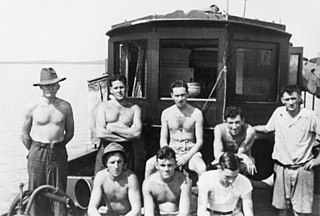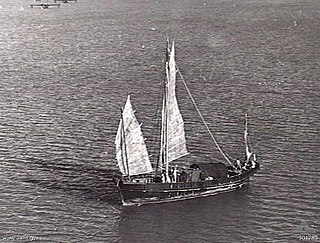Related Research Articles
A folding kayak is a direct descendant of the original Inuit kayak made of animal skins stretched over frames made from wood and bones. A modern folder has a collapsible frame made of some combination of wood, aluminium and plastic, and a skin made of a tough fabric with a waterproof coating. Many have integral air chambers inside the hull, making them virtually unsinkable.

The Battle of Timor occurred in Portuguese Timor and Dutch Timor during the Second World War. Japanese forces invaded the island on 20 February 1942 and were resisted by a small, under-equipped force of Allied military personnel—known as Sparrow Force—predominantly from Australia, United Kingdom, and the Dutch East Indies. Following a brief but stout resistance, the Japanese succeeded in forcing the surrender of the bulk of the Allied force after three days of fighting, although several hundred Australian commandos continued to wage an unconventional raiding campaign. They were resupplied by aircraft and vessels, based mostly in Darwin, Australia, about 650 km (400 mi) to the southeast, across the Timor Sea. During the subsequent fighting, the Japanese suffered heavy casualties, but they were eventually able to contain the Australians.

Operation Jaywick was a special operation undertaken in World War II. In September 1943, 14 commandos and sailors from the Allied Z Special Unit raided Japanese shipping in Singapore Harbour, sinking six ships.

The Borneo campaign or Second Battle of Borneo was the last major Allied campaign in the South West Pacific Area during World War II to liberate Japanese-held British Borneo and Dutch Borneo. Designated collectively as Operation Oboe, a series of amphibious assaults between 1 May and 21 July 1945 were conducted by the Australian I Corps, under Lieutenant-General Leslie Morshead, against Imperial Japanese forces who had been occupying the island since late 1941 – early 1942. The main Japanese formation on the island was the Thirty-Seventh Army under Lieutenant-General Masao Baba, while the naval garrison was commanded by Vice-Admiral Michiaki Kamada. The Australian ground forces were supported by US and other Allied air and naval forces, with the US providing the bulk of the shipping and logistic support necessary to conduct the operation. The campaign was initially planned to involve six stages, but eventually landings were undertaken at four locations: Tarakan, Labuan, North Borneo and Balikpapan. Guerilla operations were also carried out by Dayak tribesmen and small numbers of Allied personnel in the interior of the island. While major combat operations were concluded by mid-July, mopping-up operations continued throughout Borneo until the end of the war in August. Initially intended to secure vital airfields and port facilities to support future operations, preparatory bombardment resulted in heavy damage to the island's infrastructure, including its oil production facilities. As a result, the strategic benefits the Allies gained from the campaign were negligible.

Z Special Unit was a joint Allied special forces unit formed during the Second World War to operate behind Japanese lines in South East Asia. Predominantly Australian, Z Special Unit was a specialist reconnaissance and sabotage unit that included British, Dutch, New Zealand, Timorese and Indonesian members, predominantly operating on Borneo and the islands of the former Dutch East Indies.

The Battle of Balikpapan was the concluding stage of Operation Oboe, the campaign to liberate Japanese-held British and Dutch Borneo. The landings took place on 1 July 1945. The Australian 7th Division, composed of the 18th, 21st and 25th Infantry Brigades, with a small number of Netherlands East Indies KNIL troops, made an amphibious landing, codenamed Operation Oboe Two, a few miles north of Balikpapan. The Allied invasion fleet consisted of around 100 ships. The landing had been preceded by heavy bombing and shelling by Australian and US air and naval forces. The Allied force totalled 33,000 personnel and was commanded by Major General Edward Milford, while the Japanese force, commanded by Rear Admiral Michiaki Kamada, numbered between 8,400 and 10,000, of which between 3,100 and 3,900 were combatants. After the initial landing, the Allies secured the town and its port, and then advanced along the coast and into the hinterland, capturing the two Japanese airfields. Major combat operations concluded around 21 July, but were followed by mopping-up operations, which lasted until the end of the war in mid-August. Australian troops remained in the area until early 1946.
The name commando has been applied to a variety of Australian special forces and light infantry units that have been formed since 1941–42. The first Australian "commando" units were formed during the Second World War, where they mainly performed reconnaissance and long-range patrol roles during Australia's campaigns in New Guinea and Borneo, although other units such as M and Z Special Units performed more clandestine roles. These units were disbanded following the end of the war; however, in the 1950s it was realised that there was a need for such units again in the Australian forces. Today, the Australian Army possesses a number of units that perform more conventional direct-action type commando roles, as well as counter-terrorism response, long-range patrolling, and clandestine deep-penetration operations.

Operation Rimau was an attack on Japanese shipping in Singapore Harbour, carried out by an Allied commando unit Z Special Unit, during World War II using Australian built Hoehn military MKIII folboats. It was a follow-up to the successful Operation Jaywick which had taken place in September 1943, and was again led by Lieutenant Colonel Ivan Lyon of the Gordon Highlanders, an infantry regiment of the British Army.

The Battle of Labuan was an engagement fought between Allied and Imperial Japanese forces on the island of Labuan off Borneo during June 1945. It formed part of the Australian invasion of North Borneo, and was initiated by the Allied forces as part of a plan to capture the Brunei Bay area and develop it into a base to support future offensives.

The Snake-class junks were a class of six small vessels operated by the Royal Australian Navy (RAN) to support special forces operations in 1944 and 1945. The ships were lightly armed and were used to infiltrate special forces parties and their supplies into Japanese-held territory.
Operation Python was carried out by the Allied commando unit Z Special Unit, during World War II. The objective of the mission was to set up a wireless station near Labian Point in North Borneo and undertake covert operations reporting on the sea lane of the Imperial Japanese Navy in the Sibutu Passage and the Balabac Strait of the Sulu Sea. The operation was split into Python I and Python II.

HMAS Tiger Snake was a Snake-class junk built for the Royal Australian Navy during the Second World War. She was launched in 1945 and commissioned into the Royal Australian Navy on 22 August 1945 and was used by the Services Reconnaissance Department (SRD).

HMAS Black Snake was a Snake-class junk built for the Royal Australian Navy during the Second World War. She was launched in 1944 and commissioned into the Royal Australian Navy on 30 December 1944. She was used by the Services Reconnaissance Department (SRD) and was paid off on 3 November 1945, before being handed over to the British Civil Administration in Borneo.

HMAS River Snake was a Snake-class junk built for the Royal Australian Navy during the Second World War. She was launched in 1945 and commissioned into the Royal Australian Navy on 19 February 1945. She was used by the Services Reconnaissance Department (SRD) and was paid off on 2 November 1945, before being handed over to the British Civil Administration in Borneo.

Operation Copper was carried out by the Allied commando unit Z Special Unit, during World War II. The objective of the mission was to investigate the Japanese defences on Muschu Island, capture a Japanese officer for interrogation and discover the location of two naval guns on the island that covered the approaches to Wewak Harbour. Eight commandos were landed as part of the operation; only one survived.

Operation Semut was a series of reconnaissance operations carried out by Australia's Z Special Unit in 1945, during the final stages of World War II. This operation was the part of the Borneo Campaign, and was undertaken in Sarawak, northwestern Borneo, in support of Allied operations to secure North Borneo. Another closely related operation codenamed Agas was carried out concurrently in North Borneo. Both operations combined and relayed their intelligence through the Stallion Project to Australian forces and carried out guerrilla warfare against the Japanese in the region with the full support of the local population. A total of four operations were undertaken under the auspices of Operation Semut, concluding in September and October 1945.
Operation Scorpion was a proposed operation in World War II by Australia's Z Special Unit.
Operation Hornbill was a proposed commando operation by Australian forces during World War II.
Operation Sunlag was an Australian military operation in Timor during World War II. Its aim was to investigate what happened to Operation Lagarto.

Developed as a naval patrol aircraft, the Consolidated PBY Catalina was a widely exported flying boat during World War II. Over the course of the conflict it served with a number of different nations in a variety of roles. In the Royal Australian Air Force, PBYs and PB2Bs served as multi role bombers and scouts, the type eventually earning great renown among Australian aircrews. The motto of the Catalina squadrons was "The First and Furthest."
References
- Feuer, A.B. (2005). Australian Commandos: Their Secret War Against the Japanese in World War II. Mechanicsburg, PA: Stackpole Books. ISBN 9780811732949.
- Hoehn, John (2011). Commando Kayak: The Australian Folboat in the Pacific Campaign. Hirschbooks. ISBN 978-3-033-01717-7.
- Wigzell, Francis Alexander (2001). New Zealand Army involvement: Special Operations Australia South-West Pacific World War II. Edinburgh: Pentland Press.